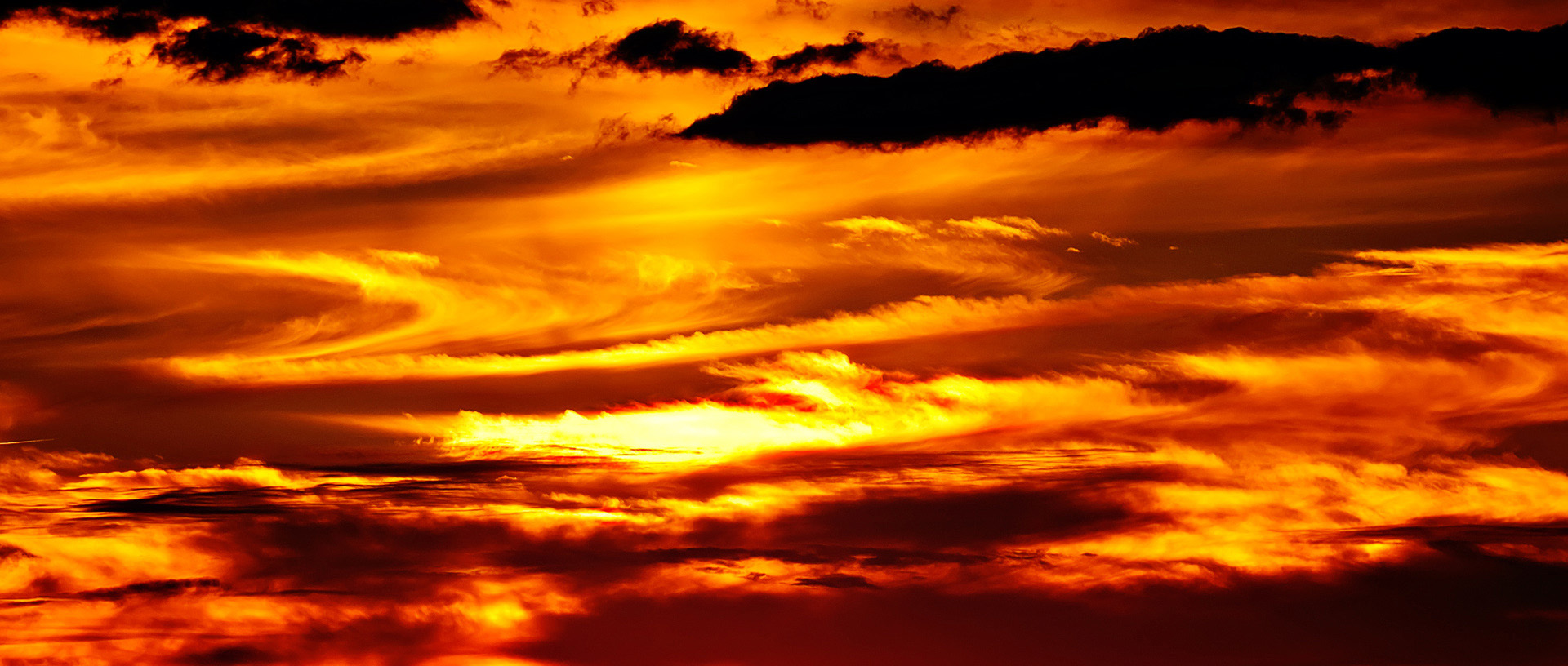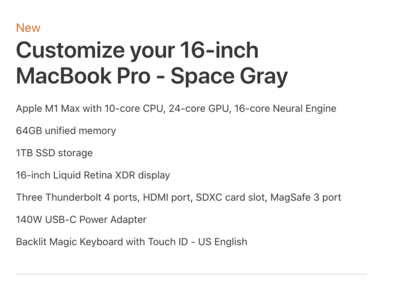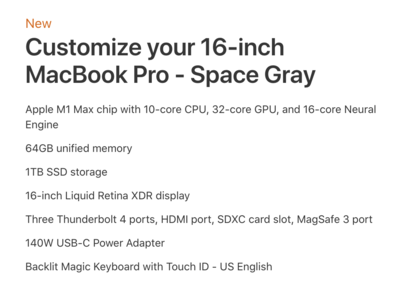-
Posts
4,097 -
Joined
-
Last visited
-
Days Won
51
Everything posted by Brian
-
Damn. Call Adobe and if you find something that fixes it, post it here for others to learn.
-
Was it checked? If it was and things are now better with PS. Turn back on all those checkboxes in the Advanced section in the Graphics Performance area.
-
Great. Close that Window. Restart your laptop and hopefully things will be better. If not, I’m out of ideas. You might have to call Adobe on this one.
-
I would also head to Apple’s website and buy/configure your iMac there. Store-bought iMacs almost never have the good components to make them last.
-
I just answered this question today on FB AD. Here are my thoughts… OK, Apple is eventually going to replace all of their computers with the new M1 or M1x CPU Chip. Macs with Intel are on their way out. That said, there is still life in a Intel-based Mac. In fact, I'm typing this comment on a 2017 iMac. 🙂 The main issue with the new M1 Macs, is that there is NO UPGRADING ANYTHING, AND I MEAN ANYTHING, AFTER THE FACT!!! The reason is, the RAM, CPU, Storage, and Video is all built into ONE big chip. So if you are looking to buy a iMac now, wait a few months to upgrade the RAM, etc. then an Intel iMac is in your future. Also, software and applications need to be encoded so that they will run natively on a M1 Mac. Photoshop CC 2021 & Photoshop CC 2022 work with the M1 chips, I believe the very latest versions of LR and Bridge also have native support. If you are an Elements user, chances are you are buying / upgrading to the very latest version. Not all software works with M1 chips, especially software like plug-ins at least as of this point. So there is that; even though your M1 iMac will have the newest technology, you are going to be in the "Early Adopter" Group and the hassles that comes with it. Now back to the hardware. Like I said above, there is no upgrading after the fact. So you are forced to pay Apple's Over-Priced Hardware upgrades, in which you are getting at least 32GB of RAM (64GB if you can swing it) 1TB for Storage Capacity, Upgrading the CPU Cores so that the GPU portion is more robust (Photoshop uses the GPU for certain components to work in addition to a performance boost.) Basically, in my humble option, you are selecting ALL the upgrades at the highest price-point to get your new M1 iMac to last 7-8 years. So what would I do? Like I said, the Intel-based iMacs still have some life in them and are proven technology that is matured. Here are some configurations worth considering, and if it were me and I needed a new iMac today, I'd get the Intel one. My next Mac in a few years will be a M1 or I'm sure it will be a M2 chip at that point and then all the software will be optimized to work, etc. https://ask.damiensymonds.net/topic/35515-quick-and-dirty-desktop-imac-configurations/ My iMac is the Middle Configuration in that article. I have 64GB of RAM that I upgraded myself for less than $200. If that was Apple RAM, that upgrade for the same damn chips would be closer to $1000. Like I said, over-priced.
-
Try turning off Use Open CL and 30 Bit Display. Then restart Photoshop. Any better or worse? If worse, you can always turn them back on. Also, lower your History States from 95 to 50. If you edit properly, you don't "Need" any more than 50 undo items. One more thing, I told you the wrong spot to change a setting. We need to disable "Automated Graphics Switching." HERE are the instructions. It seems this is a Setting with the MacOS and NOT a Photoshop setting. My bad. I have a iMac, not a Mac Laptop, so I don't always see the ALL the options/settings because I have a desktop.
-
I'm going to answer your question anyway, so that others who come across this thread can learn. THIS IS NOT A GOOD THING TO HAVE and probably the source of your woes. I wish you would have asked me if it was OK for you to upgrade. Honestly? You aren't the only one. Monterey has been bricking some Mac Laptops and Apple just released some sort of patch. I've also seen reports of other weird things with Monterey and I would avoid upgrading, even though Apple is bugging you to upgrade. If you have an older Mac, like one before 2017, it's probably not a good idea to upgrade to Monterey, as you have found out the hard way. Believe it or not, you could have upgraded to Catalina, but with the way your situation is, lack of RAM and Storage, you'd probably be in the same situation. You can't go back to a previous OS at this point. In order to accomplish this, you are formatting your internal Macintosh HD, formatting your Time Machine Drive, creating a Bootable Thumb-drive with a OS like Catalina...it's going to be a real huge pain in the ass. In a nutshell, you are nuking everything and starting all over. Same thing as you would with buying a new Mac. If your Mac was a 2017 model, then I'd be more prone to you trying to fix things. If it's any older than that, it's time for a new iMac. Quick & Dirty iMac Configurations
-

Macbook Pro 2021 - what specs do I need?
Brian replied to siobhankelly's topic in Photo Gear & Equipment
The Max is really over-kill for still photo editing, but you will have that one the longest in terms of life-span & usage. If you are doing things with Video and Recording Music, that's where the M1 Max Shines. But again, you are buying the top of the line in terms of a 2021/2022 MBP. Whichever you choose, realize you need to buy the extra things at the time of purchase, because there is no upgrade path or upgrading after the fact. If you want more, you are buying a new laptop. So make your choice a good one. In any case, are looking at spending at least $3000+ before shipping and tax, no matter how you configure things. Apple wants you to "Go Big or Go Home." Any M1 Based MBP will require PS CC 2021 or PS CC 2022. Period. So make sure you have a subscription to PS CC. Today's Photoshop requires a beefy video card in order to run well. There are certain tools built within Photoshop that use the GPU and dedicated Video RAM in order to function. So it's not about RAM, HD space and CPU speed. the GPU is more important than the CPU in 2021/2022 when it comes to Photoshop. Again, since everything is built into one chip, I'd get at least 32GB of RAM, hell...I'd bump it up to 64GB AND increase the Graphics Cores at least to the next level. (But then we are in a M1 Max Configuration.) Especially if you are thinking about getting a camera that is 45MP or more. The more MegaPixels that you have, the more RAM you will need. And Storage, and CPU... So there is never "too much." It boils down to your budget. Here is one I configured, the price is $3699 before AppleCare, Tax and possible shipping. You could configure a lower-end model, but then we are looking at $3299 or $3099. Big whoop. Since you are above $3000 in all scenarios, might as well go for broke and spend the extra $400 or so. If you are looking to save a little cash, you could pick the middle MBP and configure it with 32GB of RAM. But honestly, I have 64GB of RAM in my current iMac and shoot with a Nikon D850. I couldn't imagine going back to 32GB. -
Yep. The video drivers are part of the MacOS. They aren't available separately, at least to my knowledge. You'd have to call Apple on that one. If you want to change the graphics card, you are buying a whole new Mac. This isn't a Windows Computer. It's a Mac. Under the "Use Graphics Processor" checkbox, there is "Advanced Settings." Click on that and post a screenshot.
-
You mean the one that's pinned to the top of the forum? Quick & Dirty iMac Configurations.
-
Can you post a screenshot of your performance settings? I’m untested in the Graphics section on the right.
-
Different Driver set. Photoshop may act differently with the new OS. But performance issues like you are having scream graphics card problem.
-
Found this: Open Photoshop Choose System Preferences > Energy Saver, and then deselect Automatic Graphics Switching. Close Preferences and restart Photoshop. Source: https://helpx.adobe.com/photoshop/kb/troubleshoot-gpu-graphics-card.html
-
Your Graphics card is the likely culprit. I think PS is using the extremely underpowered Intel UHD Graphics with only 1536MB. The modern versions of Photoshop rely on the Graphics Card for a performance boost. PS needs to be using the 4GB card. I hate the Mac Laptops with two graphics cards. You might want to call Adobe on this one. I’m about to do some Googling.
-
Also, try running Windows Update again, but make sure you don't have any peripherals or external devices hooked up when you do. We just want the computer, keyboard, monitor and mouse. You can try running the built-in Windows tool, Disk Cleanup to delete things. Simply Click on the Start Button and type "Disk Cleanup" but before you click on the program in the list, select "Run as Administrator." This is very important as the next step won't appear unless this cleanup program is run as an Administrator. Yes, even if you are logged in as an Admin, it still needs elevated privileges. What I want you to click on is "Windows Update Cleanup" and make sure it's checked. Then check anything else you might want to delete. Sometimes Windows Updates get corrupted when they are downloaded and that can cause you grief. Doing this will clear out any downloaded update that is ready to be installed, and then I want you to try Windows Update again. Hopefully, your computer is hooked directly up via a hard-wired Ethernet cable and not connected to the Internet via Wi-Fi. Not only for speed, but sometimes poor Wi-Fi signals can trip you up.
-
Error Code 0xc1900101, according the Microsoft, usually means that there is a driver that isn't playing nice with Windows update. The 0xc1900223 error we aren't going to worry about, it just means Windows Update failed. (Duh!) Who built this computer? Have you checked ALL of your installed devices to see if there are any updates? This not only includes driver updates, but BIOS updates as well. I can give you a couple of commands to try, but this sort of error does not have a single fix. Ultimately, you try a bunch of stuff and you are lucky to get things working again without any rhyme-or-reason. I hate when Windows doesn't update & fails, I usually spend a good 4-5 hours trying a bunch of stuff.
-
Well, let's start here first. Details about your computer's health.
-
Yeah, the "Mac Laptop that is Good for Photo Editing" is now the most expensive 16" MBP option. It will set you back $3899 (US Dollars,) before AppleCare, Shipping and Tax. It isn't a bad setup, I just upgraded the RAM from 32GB to 64GB. Keep in mind that with all current Mac Laptops that are M1-Chip based, you need to select the upgrades AT THE TIME OF PURCHASE!! No upgrading after-the-fact. The RAM, CPU, Graphics Card and HD space are all integrated on one chip. 16GB is the Minimum in 2021, with 32GB being preferred. But if you are thinking about getting a future camera body that has 45MP or more, you will want that 64GB of RAM. 1TB HD is fine for now and if you want to spend the extra $400 on top of the 64GB RAM Upgrade, that's up to you. 2TB isn't a bad thing to have. It's only money, right? I've said this before and I will say it again, Mac Laptops are a waste of money. This is coming from a Mac-Guy. You will get better performance and more bang-for-your-buck from a tricked out 27" iMac than a MBP. But at the end-of-the-day, it's your money.
-
Well, look at that. Adobe changed it on my computer as well. Personally, on my Mac, I upgraded the Video Card when I bought it and it has 8GB of dedicated Video Memory. All my 3 boxes are checked. I'm thinking PS detected your Video Card's capabilities and I would just leave this alone. Especially since you are on a laptop, most people never think to spend the extra $600 (or whatever) to update the video card on a MacBook Pro. They get hung up on RAM and HD Space, but are un-aware that they need a beefy Video Card with dedicated Video RAM for Photoshop to work at its full potential. Again, I'd leave this setting alone for now.
-
Hmm…Adobe must have changed things. I will check my latest version of PS CC and see what’s up. Thanks!
-
It seems “fine” for me. Just make sure ACR is set to sRGB. It’s probably defaulted to Adobe RGB (1998). I wrote this a little bit ago: Setting Up Photoshop It might be worth it to spot-check things.
-
Any updates? We’re you able to upgrade to Catalina? Also, be sure to delete the update patch that didn’t work. No sense in keeping a 1GB file that won’t do anything.
-
My bad. Use Safari on this link: https://support.apple.com/en-us/HT211683 The link will take you to the App Store. Download the full MacOS Catalina. That's just the update patch. Sorry!
-
Yeah...I'd skip Big Sur. Upgrade to Catalina. That's what I'm running, with the latest-and-greatest Photoshop CC, and it's really stable right now. I'd run CMMX before and after the install. Also after upgrading, make sure it's the most recent version. Older CleanMyMacs can screw up your computer if they aren't up-to-date.
-
How old is your Mac? Actually, fill this out too and post the results in this thread : Details about your computer's health. Finally, do you own CleanMyMac X from Macpaw.com?






